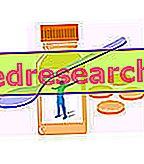Generality
DNA, or deoxyribonucleic acid, is the genetic heritage of many living organisms, including humans.

A generic DNA forming nucleotide includes 3 elements: a phosphate group, the deoxyribose sugar and a nitrogenous base.
Organized in chromosomes, DNA serves the generation of proteins, which play a fundamental role in regulating all the cellular mechanisms of an organism.
What is DNA?
DNA is the biological macromolecule that contains all the information necessary for the proper development and proper functioning of the cells of a living organism.
IT IS A NUCLEIC ACID

Thanks to the image of a generic nucleotide, the reader can see that the pentose represents the element to which the phosphate group (through a phosphodiester bond) and the nitrogenous base (through an N-glycosidic bond) are bound.
The abbreviation DNA means deoxyribonucleic acid or deoxyribonucleic acid .
Deoxyribonucleic acid belongs to the category of nucleic acids, that is biological macromolecules consisting of long chains of nucleotides .
A nucleotide is the molecular unit of a nucleic acid, resulting from the union of 3 elements:
- A phosphate group ;
- A pentose, that is a sugar with 5 carbon atoms;
- A nitrogenous base .
Another very important nucleic acid: RNA
Another fundamental nucleic acid for the proper functioning of the cells of many organisms is the RNA . The abbreviation RNA stands for ribonucleic acid .
Ribonucleic acid differs from deoxyribonucleic acid in terms of nucleotides.
WHY IS IT SAID GENETIC HERITAGE?
Genetics and molecular biology books define DNA with genetic heritage terminology.
To justify the use of this wording is the fact that DNA is the seat of genes . Genes are nucleotide sequences, from which proteins are derived. Proteins are another class of biological macromolecules indispensable for life.
In the genes of each of us, there is "written" part of what we are and what we will become.
DNA DISCOVERY
The discovery of DNA is the result of numerous scientific experiments.
The first and most important research in this regard began towards the end of the 1920s and belonged to an English medical officer named Frederick Griffith ( Griffith 's transformation experiment ). Griffith defined what we today call DNA by the term " transforming principle " and thought it was a protein.
Continuing Griffith's experiments was the American biologist Oswald Avery, with his collaborators, between 1930 and 1940. Avery showed that Griffith's "transforming principle" was not a protein, but another type of macromolecule: a nucleic acid .
The precise structure of the DNA remained unknown until 1953, when James Watson and Francis Crick proposed the so-called " double helix model ", to explain the arrangement of nucleotides within the deoxyribonucleic acid.
Watson and Crick had an incredible intuition, revealing to the entire scientific community what biologists and geneticists had been searching for years.
The discovery of the exact DNA structure made possible the study and understanding of the biological processes in which deoxyribonucleic acid is involved: from how it replicates and forms RNA (another nucleic acid) to how it generates proteins.
Fundamental to the description of the Watson and Crick model were some studies conducted by Rosaling Franklin, Maurice Wilkins and Erwin Chargaff .
Structure
The so-called "double helix model" by Watson and Crick showed that DNA is a very long molecule, formed by two strands of nucleotides (polynucleotide filaments). United to each other but oriented in opposite directions, these two polynucleotide filaments wrap one another, like a spiral.

Since the structure of DNA is a fairly complex topic, we will try to cite the most important points, without exceeding the details.
WHAT IS THE DNA PENTOSO?
The sugar with 5 carbon atoms, which distinguishes the structure of DNA nucleotides, is deoxyribose .
Of the 5 carbon atoms of the deoxyribose, 3 deserve a special mention:
- The so-called " carbon 1 ", because it is what joins the nitrogenous base ;
- The so-called " carbon 2 ", because it is what gives the name of deoxyribose to sugar (NB: deoxyribose means "oxygen-free" and refers to the absence of oxygen atoms linked to carbon);
- The so-called " carbon 5 ", because it is what binds to the phosphate group .
Comparison with RNA
Pentose is ribose in RNA molecules. Ribose differs from deoxyribose only due to the presence, on the "carbon 2", of an oxygen atom.
The reader can appreciate this one difference by looking at the figure below.

TYPES OF NUCLEOTIDS AND NITROGEN BASES
DNA has 4 different types of nucleotides .
To distinguish these elements is only the nitrogenous base, linked to the pentose-phosphate group skeleton (which unlike the base never varies).
For obvious reasons, the nitrogenous bases of DNA are 4: adenine (A), guanine (G), cytosine (C) and thymine (T).
Adenine and guanine belong to the class of purine, double-ring heterocyclic compounds.
Cytosine and thymine, on the other hand, fall into the category of pyrimidines, single-ring heterocyclic compounds.
The double helix model by Watson and Crick made it possible to clarify two completely unknown aspects at the time:
- Each nitrogenous base present on a strand of DNA joins a nitrogenous base present on the other strand of DNA, effectively forming a pair, a pairing, of bases.
- The pairing between the nitrogenous bases of the two strands is highly specific. In fact, adenine joins only thymine, while cytosine binds only to guanine.
After this second sensational discovery, molecular biologists and geneticists called adenine and thymine bases and cytosine and guanine bases " complementary to each other ".
The identification of complementary pairing between nitrogenous bases was the key to explaining the physical dimensions of DNA and the particular stability enjoyed by the two strands.
A generic human DNA molecule contains about 3.3 billion basic nitrogenous pairs (which are about 3.3 billion nucleotides per filament).
Comparison with RNA
In RNA molecules, the nitrogenous bases are adenine, guanine, cytosine and uracil . The latter is a pyrimidine and replaces the thymine.

BOND AMONG THE NUCLEOTIDES
To hold together the nucleotides of each single strand of DNA are phosphodiester-type bonds, between the phosphate group of a nucleotide and the so-called "carbon 5" of the immediately following nucleotide.
FILAMENTS HAVE OPPOSITE ORIENTATION
The DNA strands have two ends, called 5 '(read "five first") and 3' (read "three first"). By convention, biologists and geneticists have established that the 5 ' end represents the head of a DNA strand, while the 3' end represents the tail .
In proposing their "double helix model", Watson and Crick claimed that the two strands making up the DNA have opposite orientation. This means that the head and tail of a filament interact, respectively, with the tail and the head of the other filament.
Brief study of the 5 'end and 3' end
The phosphate group bound to the "carbon 5" of a nucleotide is its 5 'end, while the hydroxyl group bound to the "carbon 3" (-OH in the figure) represents its extremity 3'.
The union of several nucleotides maintains this disposition and it is for this reason that, in the books of genetics and molecular biology, the DNA sequences are described as follows: P-5 '→ 3'-OH
* Please note: the capital letter P identifies the phosphorus atom of the phosphate group.
SEAT IN THE CELL AND CHROMOSOMES
Eukaryotic organisms (the human being is among them) possess, in the core of each of their cells, an equal (and personal) DNA molecule .
In the nucleus (always in an eukaryotic organism), DNA is organized in different chromosomes . Each chromosome contains a precise stretch of DNA associated with specific proteins (histones, coexines and condenses). The association between DNA and chromosomal proteins is called chromatin .
Chromosomes in humans
An organism is diploid when the DNA, inside the cellular nucleus, is organized in pairs of chromosomes (called homologous chromosomes ).
The human being is a diploid organism, as it has 23 pairs of homologous chromosomes (therefore 46 chromosomes in all) in its somatic cells.
As in many other organisms, each of these couples has a chromosome of maternal origin and a chromosome of paternal origin.
In this picture just described, to represent a case in itself are the sex cells (or gametes): these possess half of the chromosomes of a normal somatic cell (therefore 23, in the human being) and are called, for this reason, haploid .
A human sex cell reaches the normal set of 46 chromosomes during fertilization.
Function
DNA serves for the generation of proteins, macromolecules indispensable in regulating the cellular mechanisms of an organism.

Human chromosomes
The process that leads to the formation of proteins is very complex and includes a fundamental intermediate step: the transcription of DNA into RNA .
The RNA molecule is comparable to a dictionary, as it allows the translation of DNA nucleotides into the amino acids of proteins .
To deal with protein synthesis - a process which, not surprisingly, is called a translation - are some small cellular organelles, known as ribosomes .
DNA → RNA → protein is what experts call central dogma of molecular biology.



